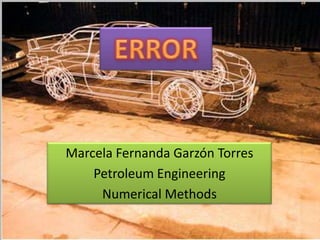Melden
Teilen

Empfohlen
Weitere ähnliche Inhalte
Was ist angesagt?
Was ist angesagt? (10)
Andere mochten auch
Andere mochten auch (10)
Ähnlich wie Error
Ähnlich wie Error (20)
Numerical analysis using Scilab: Error analysis and propagation

Numerical analysis using Scilab: Error analysis and propagation
About the size and frequency of prime gapsMaximum prime gaps

About the size and frequency of prime gapsMaximum prime gaps
Instrumentation & Measurement: Error and Its Types

Instrumentation & Measurement: Error and Its Types
Numerical analysis using Scilab: Numerical stability and conditioning

Numerical analysis using Scilab: Numerical stability and conditioning
Mehr von marcelafernandagarzon
Mehr von marcelafernandagarzon (10)
Some methods for small systems of equations solutions

Some methods for small systems of equations solutions
Series contribution to the numerical approximations

Series contribution to the numerical approximations
Error
- 1. ERROR Marcela Fernanda Garzón Torres PetroleumEngineering NumericalMethods
- 2. MEANING ERROR In mathematics and physics, the error is the difference between a value calculation and the real value "A minimum error can be up to the top end." Aristotle "Un error mínimo al principio puede ser máximo al final."Aristóteles
- 4. ERROR TYPES Approximation Error: Is presented to express a more simple approach of a numerical scale rather than the actual size http://www.cienciakanija.com/wp-content/uploads/quantum_threat_to_relativity_1.jpg
- 5. found several types of errors but the common ones are as follows a) Error por truncamiento: Assuming we want to calculate 24 / 7, we know that the outcome of this fraction is 3.428571 ... Truncating to two decimals, then 3.42 only, its expression as 171/50 would be broken, and this, as you can see, is generating an error.
- 6. b) Error due to rounding Taking the example above, if rounded to two decimals, then 3.43 only, its expression as 343/100 would be broken, and this will generate an error, as in the previous case.
- 8. Absolute error (AE): It is the difference between the actual value (RV) and approximate value (VA).
- 9. b) Relative error is the percentage difference between the absolute value and real value. Y is calculated as
- 10. BIBLIOGRAPHY www.fisicanet.com.ar/fisica/.../ap01_errores.php 200.45.54.90/depar/areas/matematica/.../5.../tema_AproxiNum_2009.pdf fcqi.tij.uabc.mx/docentes/esqueda/curso_m3.swf html.rincondelvago.com/metodos-numericos_5.html